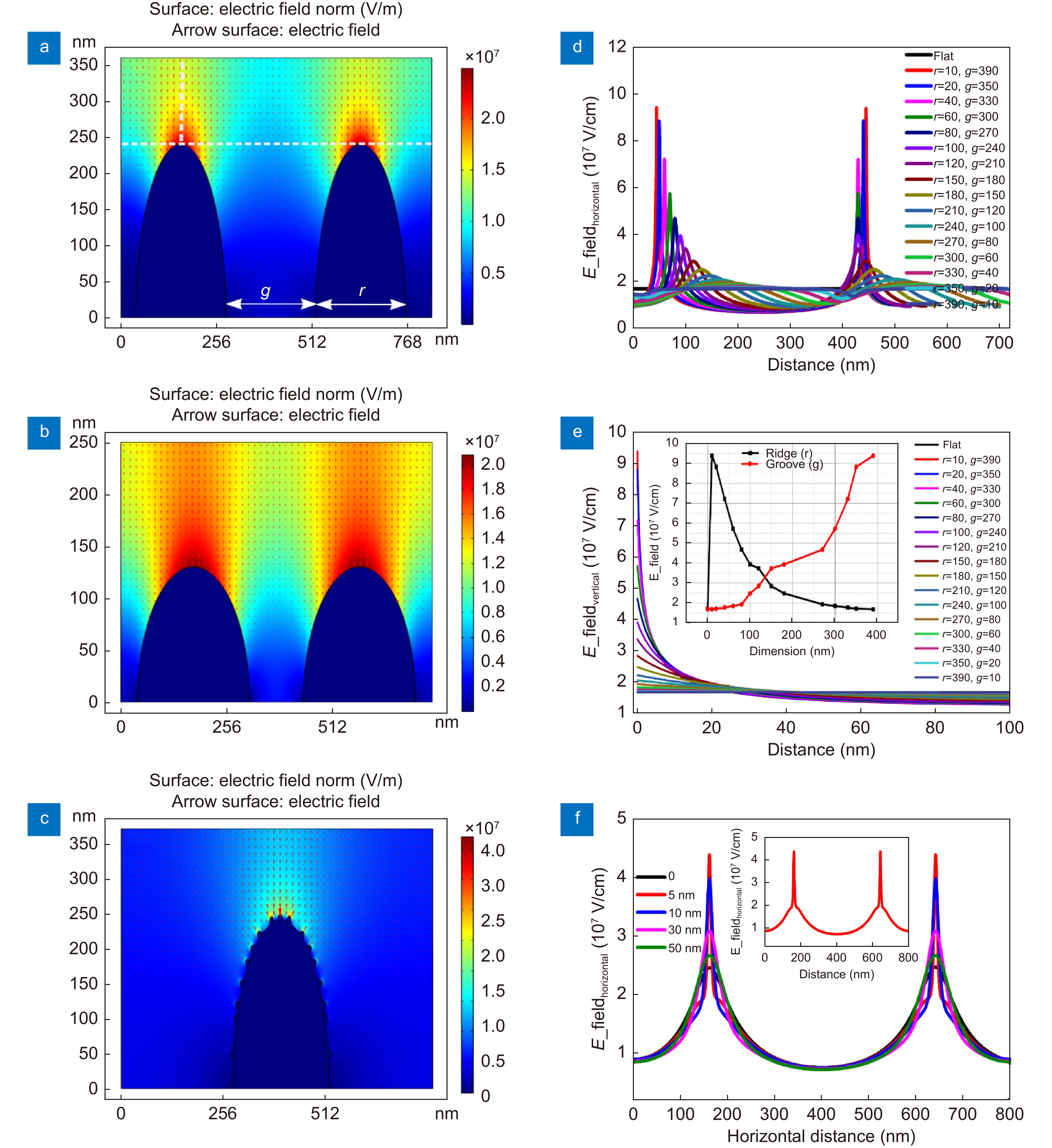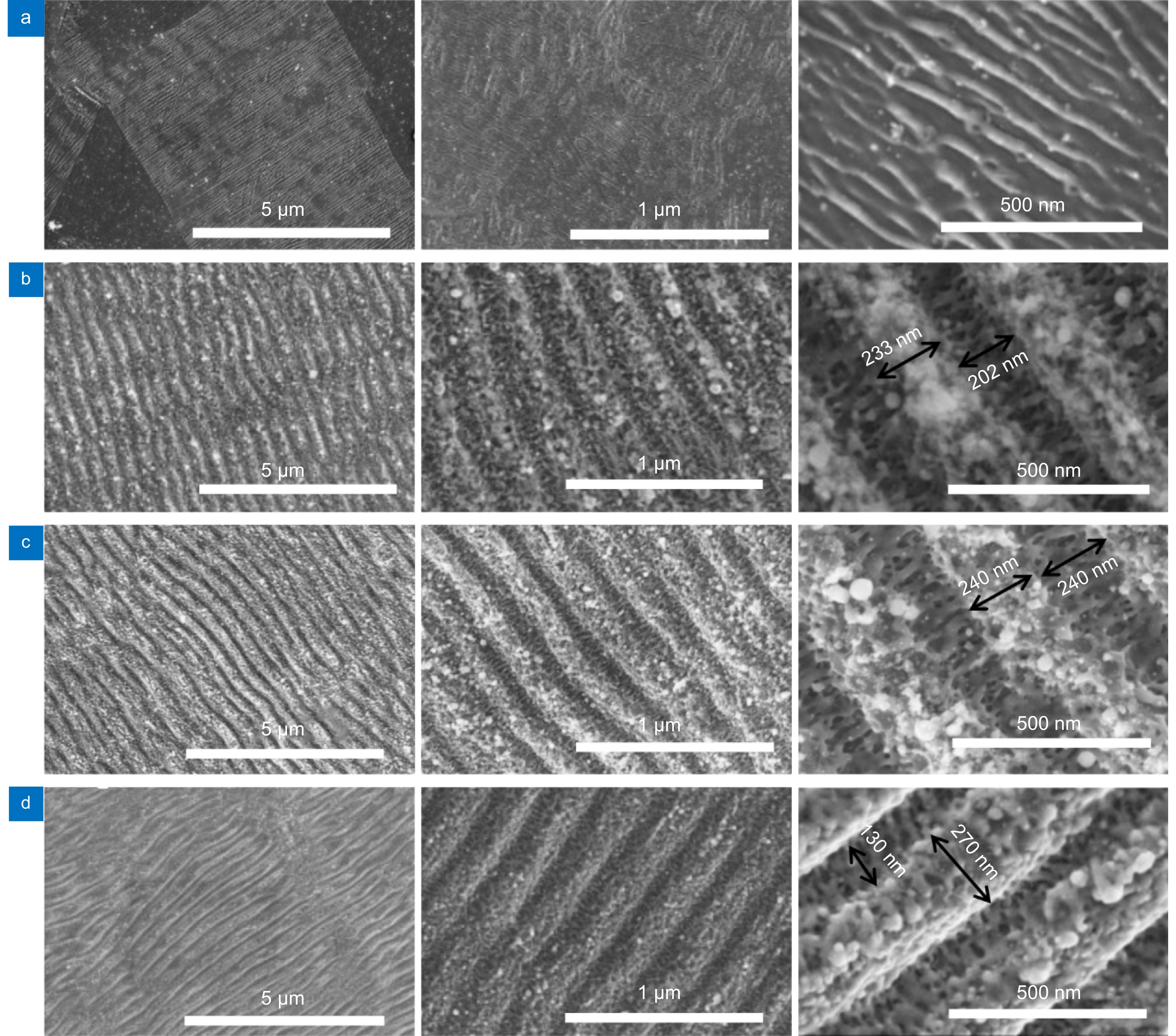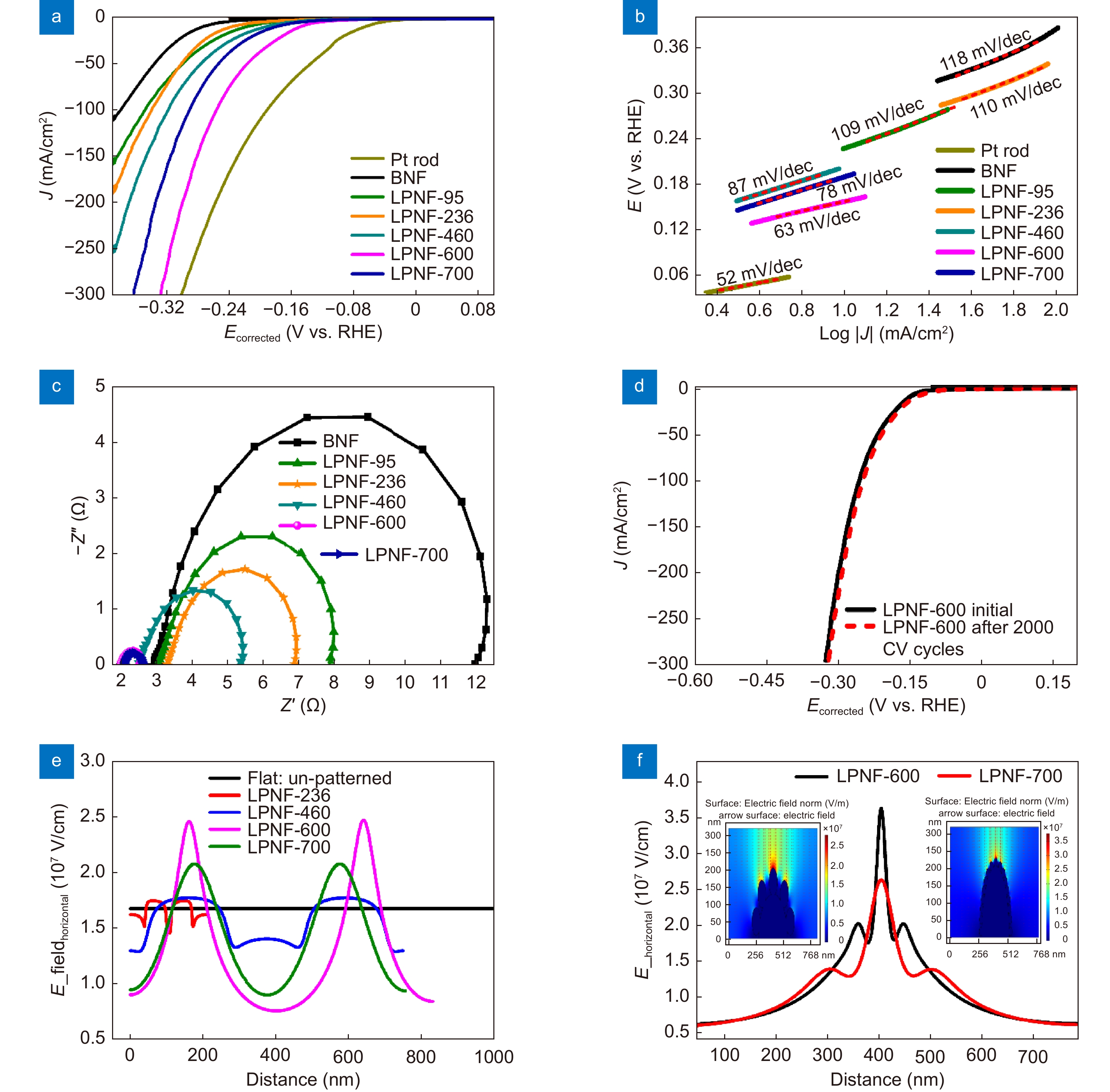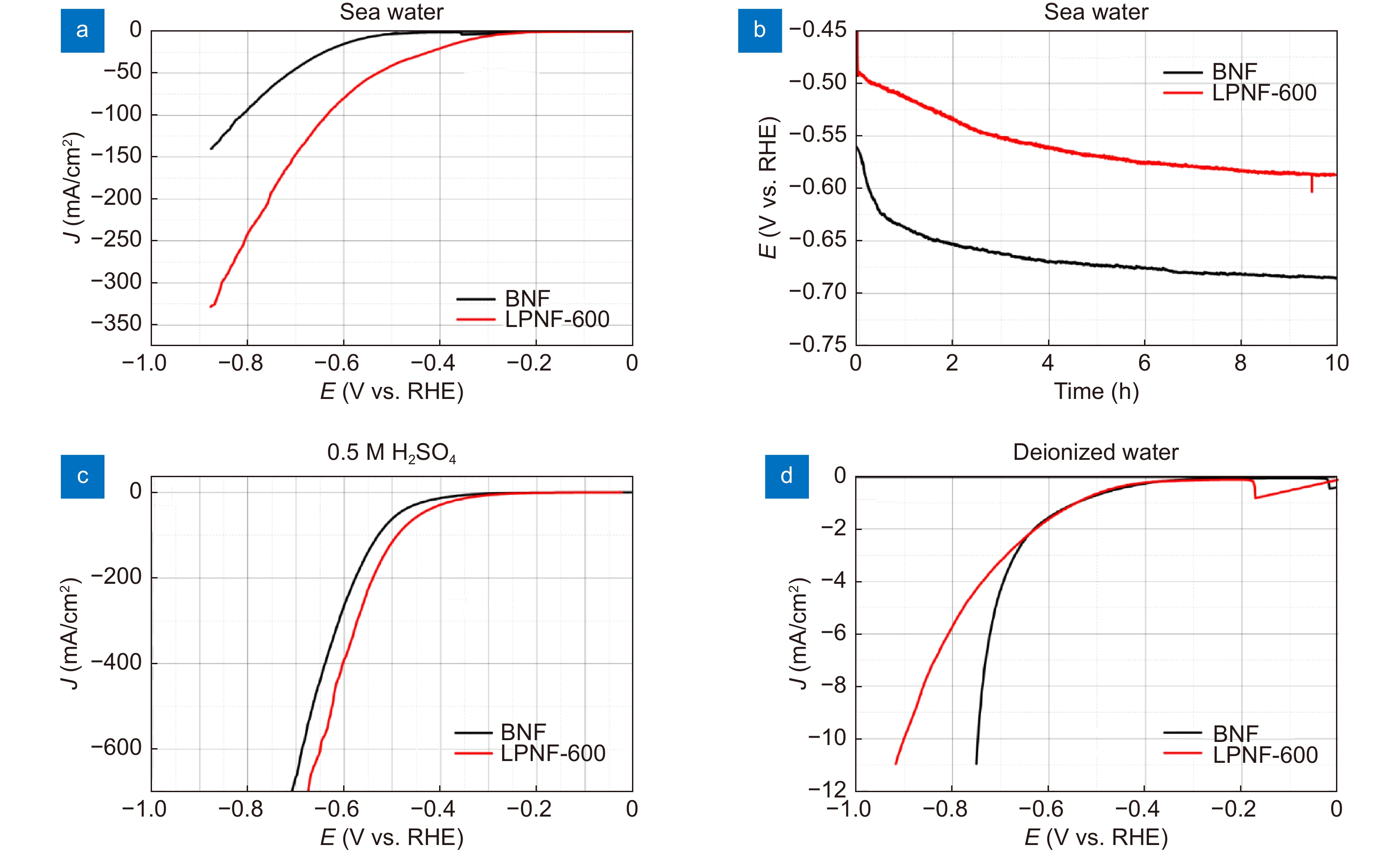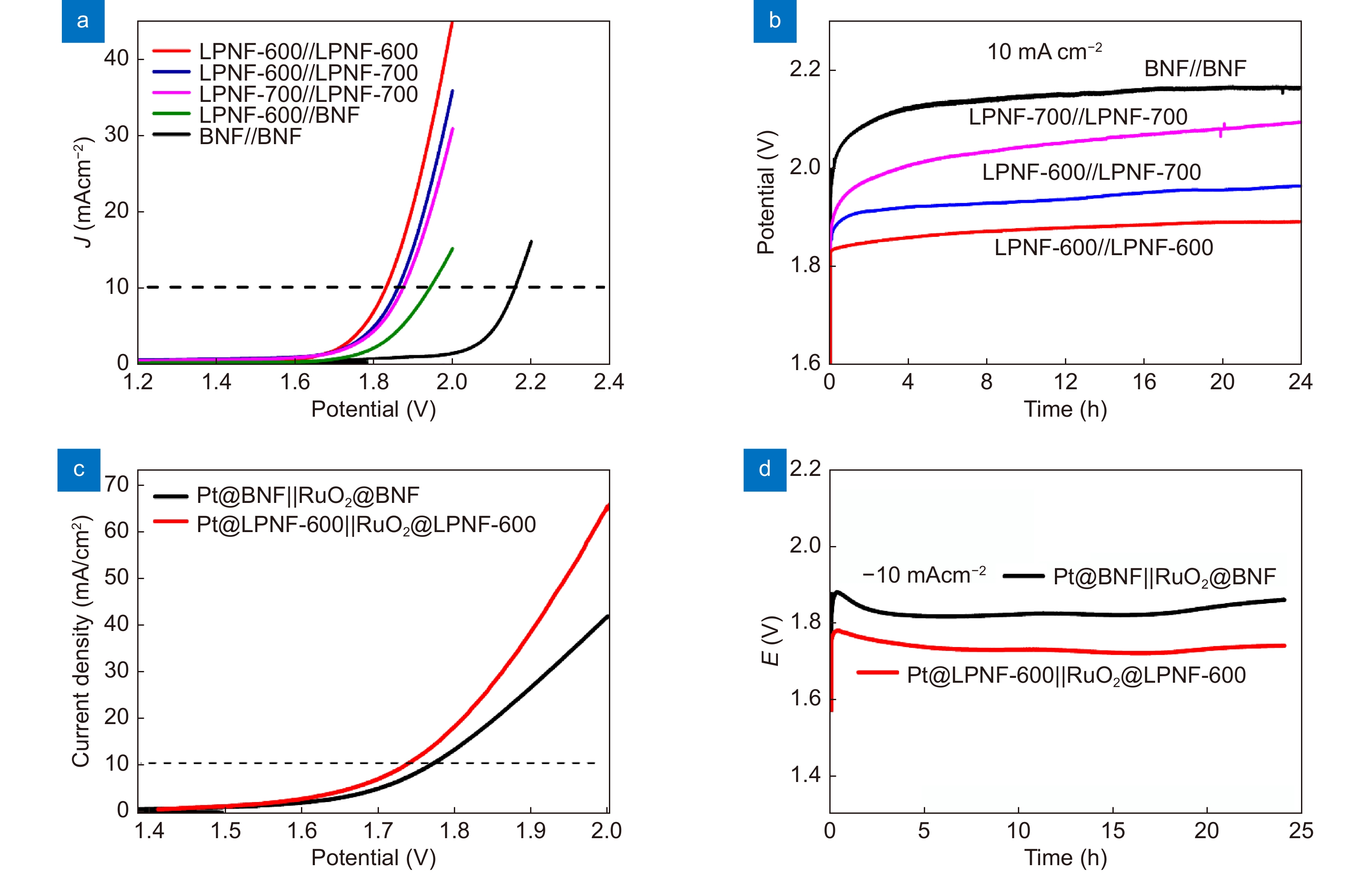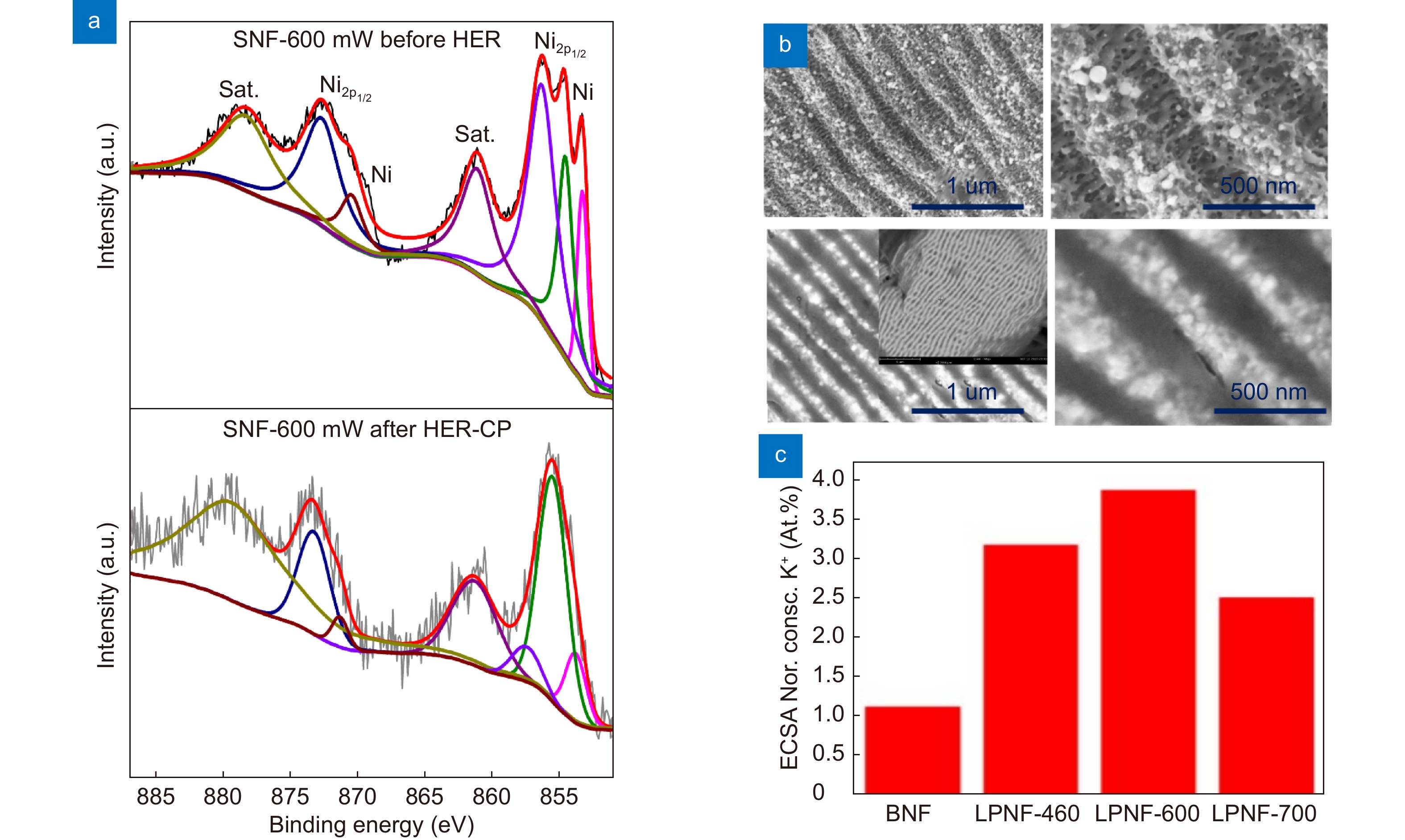| Citation: | Saraj CS, Singh SC, Verma G, Rajan RA, Li W et al. Laser-induced periodic surface structured electrodes with 45% energy saving in electrochemical fuel generation through field localization. Opto-Electron Adv 5, 210105 (2022). doi: 10.29026/oea.2022.210105 |
Laser-induced periodic surface structured electrodes with 45% energy saving in electrochemical fuel generation through field localization
-
Abstract
Electrochemical oxidation/reduction of radicals is a green and environmentally friendly approach to generating fuels. These reactions, however, suffer from sluggish kinetics due to a low local concentration of radicals around the electrocatalyst. A large applied electrode potential can enhance the fuel generation efficiency via enhancing the radical concentration around the electrocatalyst sites, but this comes at the cost of electricity. Here, we report about a ~45% saving in energy to achieve an electrochemical hydrogen generation rate of 3×1016 molecules cm–2s–1 (current density: 10 mA/cm2) through localized electric field-induced enhancement in the reagent concentration (LEFIRC) at laser-induced periodic surface structured (LIPSS) electrodes. The finite element model is used to simulate the spatial distribution of the electric field to understand the effects of LIPSS geometric parameters in field localization. When the LIPSS patterned electrodes are used as substrates to support Pt/C and RuO2 electrocatalysts, the η10 overpotentials for HER and OER are decreased by 40.4 and 25%, respectively. Moreover, the capability of the LIPSS-patterned electrodes to operate at significantly reduced energy is also demonstrated in a range of electrolytes, including alkaline, acidic, neutral, and seawater. Importantly, when two LIPSS patterned electrodes were assembled as the anode and cathode into a cell, it requires 330 mVs of lower electric potential with enhanced stability over a similar cell made of pristine electrodes to drive a current density of 10 mA/cm2. This work demonstrates a physical and versatile approach of electrode surface patterning to boost electrocatalytic fuel generation performance and can be applied to any metal and semiconductor catalysts for a range of electrochemical reactions. -

-
References
[1] Montzka SA, Dutton GS, Yu PF, Ray E, Portmann RW et al. An unexpected and persistent increase in global emissions of ozone-depleting CFC-11. Nature 557, 413–417 (2018). doi: 10.1038/s41586-018-0106-2 [2] Knobloch F, Hanssen SV, Lam A, Pollitt H, Salas P et al. Net emission reductions from electric cars and heat pumps in 59 world regions over time. Nat Sustain 3, 437–447 (2020). doi: 10.1038/s41893-020-0488-7 [3] Duan CC, Kee R, Zhu HY, Sullivan N, Zhu LZ et al. Highly efficient reversible protonic ceramic electrochemical cells for power generation and fuel production. Nat Energy 4, 230–240 (2019). doi: 10.1038/s41560-019-0333-2 [4] Bak T, Nowotny J, Rekas M, Sorrell CC. Photo-electrochemical hydrogen generation from water using solar energy. Materials-related aspects. Int J Hydrogen Energy 27, 991–1022 (2002). [5] Saraj CS, Singh SC, Shukla A, Yu WL, Fayyaz MU et al. Single-step and sustainable fabrication of Ni(OH)2/Ni foam water splitting catalysts via electric field assisted pulsed laser ablation in liquid. ChemElectroChem 8, 209–217 (2021). doi: 10.1002/celc.202001511 [6] Lai B, Singh SC, Bindra JK, Saraj CS, Shukla A et al. Hydrogen evolution reaction from bare and surface-functionalized few-layered MoS2 nanosheets in acidic and alkaline electrolytes. Mater Today Chem 14, 100207 (2019). doi: 10.1016/j.mtchem.2019.100207 [7] Shaik S, de Visser SP, Kumar D. External electric field will control the selectivity of enzymatic-like bond activations. J Am Chem Soc 126, 11746–11749 (2004). doi: 10.1021/ja047432k [8] Hirao H, Chen H, Carvajal MA, Wang Y, Shaik S. Effect of external electric fields on the C−H bond activation reactivity of nonheme iron−oxo reagents. J Am Chem Soc 130, 3319–3327 (2008). doi: 10.1021/ja070903t [9] Chung YJ, Yang CS, Lee JT, Wu GH, Wu JM. Coupling effect of piezo–flexocatalytic hydrogen evolution with hybrid 1T- and 2H-phase few-layered MoSe2 nanosheets. Adv Energy Mater 10, 2002082 (2020). doi: 10.1002/aenm.202002082 [10] Wu YZ, Zhai PL, Cao SY, Li ZW, Zhang B et al. CO2 reduction: beyond d orbits: steering the selectivity of electrochemical CO2 reduction via hybridized sp band of sulfur-incorporated porous cd architectures with dual collaborative sites (Adv. Energy Mater. 45/2020). Adv Energy Mater 10, 2070183 (2020). doi: 10.1002/aenm.202070183 [11] Zhang JZ, Reisner E. Advancing photosystem II photoelectrochemistry for semi-artificial photosynthesis. Nat Rev Chem 4, 6–21 (2020). doi: 10.1038/s41570-019-0149-4 [12] Feng YW, Han K, Jiang T, Bian ZF, Liang X et al. Self-powered electrochemical system by combining Fenton reaction and active chlorine generation for organic contaminant treatment. Nano Res 12, 2729–2735 (2019). doi: 10.1007/s12274-019-2506-5 [13] Gao SY, Su JZ, Wei XJ, Wang M, Tian M et al. Self-powered electrochemical oxidation of 4-aminoazobenzene driven by a triboelectric nanogenerator. ACS Nano 11, 770–778 (2017). doi: 10.1021/acsnano.6b07183 [14] Mase K, Yoneda M, Yamada Y, Fukuzumi S. Seawater usable for production and consumption of hydrogen peroxide as a solar fuel. Nat Commun 7, 11470 (2016). doi: 10.1038/ncomms11470 [15] Xie JF, Zhang H, Li S, Wang RX, Sun X et al. Defect-rich MoS2 ultrathin nanosheets with additional active edge sites for enhanced electrocatalytic hydrogen evolution. Adv Mater 25, 5807–5813 (2013). doi: 10.1002/adma.201302685 [16] Benson J, Li MX, Wang SB, Wang P, Papakonstantinou P. Electrocatalytic hydrogen evolution reaction on edges of a few layer molybdenum disulfide nanodots. ACS Appl Mater Interfaces 7, 14113–14122 (2015). doi: 10.1021/acsami.5b03399 [17] Kong DS, Wang HT, Cha JJ, Pasta M, Koski KJ et al. Synthesis of MoS2 and MoSe2 films with vertically aligned layers. Nano Lett 13, 1341–1347 (2013). doi: 10.1021/nl400258t [18] Kibsgaard J, Chen ZB, Reinecke BN, Jaramillo TF. Engineering the surface structure of MoS2 to preferentially expose active edge sites for electrocatalysis. Nat Mater 11, 963–969 (2012). doi: 10.1038/nmat3439 [19] Gong M, Li YG, Wang HL, Liang YY, Wu JZ et al. An advanced Ni–Fe layered double hydroxide electrocatalyst for water oxidation. J Am Chem Soc 135, 8452–8455 (2013). doi: 10.1021/ja4027715 [20] Chen ZB, Cummins D, Reinecke BN, Clark E, Sunkara MK et al. Core–shell MoO3–MoS2 nanowires for hydrogen evolution: a functional design for electrocatalytic materials. Nano Lett 11, 4168–4175 (2011). doi: 10.1021/nl2020476 [21] Li ZH, Jalil SA, Singh SC, Li WS, Wei XM et al. Significantly enhanced electrocatalytic activity of copper for hydrogen evolution reaction through femtosecond laser blackening. Int J Hydrogen Energy 46, 10783–10788 (2021). doi: 10.1016/j.ijhydene.2020.12.174 [22] Zhang HY, Tian Y, Zhao JX, Cai QH, Chen ZF. Small dopants make big differences: enhanced electrocatalytic performance of MoS2 monolayer for oxygen reduction reaction (ORR) by N– and P–doping. Electrochim Acta 225, 543–550 (2017). doi: 10.1016/j.electacta.2016.12.144 [23] Wang HT, Tsai C, Kong DS, Chan K, Abild-Pedersen F et al. Transition-metal doped edge sites in vertically aligned MoS2 catalysts for enhanced hydrogen evolution. Nano Res 8, 566–575 (2015). doi: 10.1007/s12274-014-0677-7 [24] Tsai C, Abild-Pedersen F, Nørskov JK. Tuning the MoS2 edge-site activity for hydrogen evolution via support interactions. Nano Lett 14, 1381–1387 (2014). doi: 10.1021/nl404444k [25] Rajan RA, Konda SR, Saraj CS, Lai YH, Verma G et al. Long-term seawater anti-corrosion properties of Al alloy triggered by femtosecond laser structuring with phase change. Appl Surf Sci 573, 151612 (2022). doi: 10.1016/j.apsusc.2021.151612 [26] Peng YD, Cao JY, Sha Y, Yang WJ, Li L et al. Laser solid-phase synthesis of single-atom catalysts. Light Sci Appl 10, 168 (2021). doi: 10.1038/s41377-021-00603-9 [27] Welborn VV, Pestana LR, Head-Gordon T. Computational optimization of electric fields for better catalysis design. Nat Catal 1, 649–655 (2018). doi: 10.1038/s41929-018-0109-2 [28] Fried SD, Bagchi S, Boxer SG. Extreme electric fields power catalysis in the active site of ketosteroid isomerase. Science 346, 1510–1514 (2014). doi: 10.1126/science.1259802 [29] Liu M, Pang YJ, Zhang B, De Luna P, Voznyy O et al. Enhanced electrocatalytic CO2 reduction via field-induced reagent concentration. Nature 537, 382–386 (2016). doi: 10.1038/nature19060 [30] Safaei TS, Mepham A, Zheng XL, Pang YJ, Dinh CT et al. High-density nanosharp microstructures enable efficient CO2 electroreduction. Nano Lett 16, 7224–7228 (2016). doi: 10.1021/acs.nanolett.6b03615 [31] Geng CY, Li JL, Schlangen M, Shaik S, Sun XY et al. Oriented external electric fields as mimics for probing the role of metal ions and ligands in the thermal gas-phase activation of methane. Dalton Trans 47, 15271–15277 (2018). doi: 10.1039/C8DT03048K [32] Shaik S, Mandal D, Ramanan R. Oriented electric fields as future smart reagents in chemistry. Nat Chem 8, 1091–1098 (2016). doi: 10.1038/nchem.2651 [33] Huang XY, Tang C, Li JQ, Chen LC, Zheng JT et al. Electric field-induced selective catalysis of single-molecule reaction. Sci Adv 5, eaaw3072 (2019). doi: 10.1126/sciadv.aaw3072 [34] Chen QX, Liu YH, Qi XZ, Liu JW, Jiang HJ et al. Ordered nanostructure enhances electrocatalytic performance by directional micro-electric field. J Am Chem Soc 141, 10729–10735 (2019). doi: 10.1021/jacs.9b03617 [35] Zhang JH, Elkabbash M, Wei R, Singh SC, Lam B et al. Plasmonic metasurfaces with 42.3% transmission efficiency in the visible. Light Sci Appl 8, 53 (2019). doi: 10.1038/s41377-019-0164-8 [36] Bhuvana T, Kulkarni GU. Highly conducting patterned Pd nanowires by direct-write electron beam lithography. ACS Nano 2, 457–462 (2008). doi: 10.1021/nn700372h [37] Zhang JH, Cong C, Guo CL. Single-step maskless nano-lithography on glass by femtosecond laser processing. J Appl Phys 127, 163102 (2020). doi: 10.1063/1.5142700 [38] He YZ, Zhang JH, Singh S, Garcell E, Vorobyev AY et al. Maskless laser nano-lithography of glass through sequential activation of multi-threshold ablation. Appl Phys Lett 114, 133107 (2019). doi: 10.1063/1.5080344 [39] Jalil SA, Elkabbash M, Cong C, Wei R, Akram M et al. Controlling Voronoi partitions on femtosecond-laser-superheated metal surfaces. Appl Surf Sci 568, 150913 (2021). [40] Chen L, Cao KQ, Li YL, Liu JK, Zhang SA et al. Large-area straight, regular periodic surface structures produced on fused silica by the interference of two femtosecond laser beams through cylindrical lens. Opto-Electron Adv 4, 200036 (2021). [41] Luo X, Ji P, Wang P, Cheng R, Chen D, et al. Interface Engineering of Hierarchical Branched Mo-Doped Ni3S2/NixPy Hollow Heterostructure Nanorods for Efficient Overall Water Splitting. Adv. Energy Mater. 2020, 10, 1903891. https://doi.org/10.1002/aenm.201903891 [42] Luo X, Ji PX, Wang PY, Cheng RL et al. Interface Engineering of Hierarchical Branched Mo-Doped Ni3S2/NixPy Hollow Heterostructure Nanorods for Efficient Overall Water Splitting. Adv Energy Mater 10, 1903891 (2020). doi: 10.1002/aenm.201903891 [43] Bonse J, Gräf S. Maxwell meets marangoni—a review of theories on laser-induced periodic surface structures. Laser Photonics Rev 14, 2000215 (2020). doi: 10.1002/lpor.202000215 [44] Bonse J, Höhm S, Kirner SV, Rosenfeld A, Krüger J. Laser-induced periodic surface structures— a scientific evergreen. IEEE J Sel Top Quantum Electron 23, 9000615 (2017). [45] Wang B, Singh SC, Lu HY, Guo CL. Design of aluminum bowtie nanoantenna array with geometrical control to tune LSPR from UV to near-IR for optical sensing. Plasmonics 15, 609–621 (2020). doi: 10.1007/s11468-019-01071-z [46] Chamoli SK, Singh SC, Guo CL. 1-D metal-dielectric-metal grating structure as an ultra-narrowband perfect plasmonic absorber in the visible and its application in glucose detection. Plasmonics 15, 1339–1350 (2020). doi: 10.1007/s11468-020-01161-3 [47] Somers P, Liang ZH, Johnson JE, Boudouris BW, Pan L et al. Rapid, continuous projection multi-photon 3D printing enabled by spatiotemporal focusing of femtosecond pulses. Light Sci Appl 10, 199 (2021). doi: 10.1038/s41377-021-00645-z [48] Liu HG, Lin WX, Hong MH. Hybrid laser precision engineering of transparent hard materials: challenges, solutions and applications. Light Sci Appl 10, 162 (2021). doi: 10.1038/s41377-021-00596-5 [49] Wang B, Zhao C, Lu HY, Zou TT, Singh SC et al. SERS study on the synergistic effects of electric field enhancement and charge transfer in an Ag2S quantum dots/plasmonic bowtie nanoantenna composite system. Photonics Res 8, 548–563 (2020). doi: 10.1364/PRJ.383612 [50] Wang B, Zou YT, Lu HY, Kong WC, Singh SC et al. Boosting perovskite photodetector performance in NIR using plasmonic bowtie nanoantenna arrays. Small 16, 2001417 (2020). doi: 10.1002/smll.202001417 [51] Yao CN, Kotb A, Kotb A, Wang B, Singh SC et al. All-optical logic gates using dielectric-loaded waveguides with quasi-rhombus metasurfaces. Opt Lett 45, 3769–3772 (2020). doi: 10.1364/OL.396978 [52] Jalil SA, Elkabbash M, Zihao L, Zhang JH, Singh S et al. Multipronged heat-exchanger based on femtosecond laser-nano/microstructured Aluminum for thermoelectric heat scavengers. Nano Energy 75, 104987 (2020). doi: 10.1016/j.nanoen.2020.104987 [53] Jalil SA, Yang JJ, Elkabbash M, Lei YH, He WL et al. Formation of uniform two-dimensional subwavelength structures by delayed triple femtosecond laser pulse irradiation. Opt Lett 44, 2278–2281 (2019). doi: 10.1364/OL.44.002278 [54] Yao CN, Wang YL, Zhang JH, Zhang XL, Zhao C et al. Dielectric nanoaperture metasurfaces in silicon waveguides for efficient and broadband mode conversion with an ultrasmall footprint. Adv Opt Mater 8, 2000529 (2020). doi: 10.1002/adom.202000529 [55] Chamoli SK, Singh S, Guo CL. Metal–dielectric–metal metamaterial-based hydrogen sensors in the water transmission window. IEEE Sens Lett 4, 3500904 (2020). [56] Chamoli SK, Singh SC, Guo CL. Design of extremely sensitive refractive index sensors in infrared for blood glucose detection. IEEE Sens J 20, 4628–4634 (2020). doi: 10.1109/JSEN.2020.2964715 [57] Chen ZG, Segev M. Highlighting photonics: looking into the next decade. eLight 1, 2 (2021). doi: 10.1186/s43593-021-00002-y [58] Singh SC, Elkabbash M, Li ZL, Li XH, Regmi B et al. Solar-trackable super-wicking black metal panel for photothermal water sanitation. Nat Sustain 3, 938–946 (2020). doi: 10.1038/s41893-020-0566-x -
Supplementary Information
Supplementary information for Laser-induced periodic surface structured electrodes with 45% energy saving in electrochemical fuel generation through field localization 
-
Access History

Article Metrics
-
Figure 1.
Schematic illustrations of LIPSS formation, localized electric field induced enhancement in reagent concentration and experimental results of decrease in electrical energy. Schematic of LIPSS formation (a) surface plasmon polariton (SPP) generation and propagation parallel to the surface, (b) interference between the incident light wave and SPP wave to modulate the light intensity, and (c) imprinting of the interference pattern through selective ablation of material. (d) Schematic of the Gouy-Chapman-Stern electrical double layer model to represent mechanism behind localized electric field induced enhancement in the reagent concentration, and (e) experimental results showing percentage decrease in the required electrical potential to generate 10 mA/cm2 of current density using the LIPSS patterned electrodes in different electrolytes (i.e., alkaline, seawater (SW) neutral, acidic solutions).
-
Figure 2.
Finite Element Model (FEM) simulation for the spatial distribution of the electric fields around the ridges and grooves of –1 V biased LIPSS patterns. Electric field mapping without considering nanoparticles on the ridges and grooves with geometric parameters (a) g:180 nm, r:150 nm, and h: 240 nm, and (b) g: 100 nm, r: 240 nm and h: 125 nm, and (c) with the addition of 5 nm nanoparticles at the ridge. Electric field intensity along the (d) horizontal and (e) vertical dotted lines, shown in (a), for LIPSSs patterns of different geometric parameters without nanoparticles, inset of (e) showing the variation in the electric field intensity with respect to dimension of ridges and groove. (f) Spatial variation in the electric field intensity along the horizontal dotted line for the LIPSS pattern shown in (a) with the addition of spherical nanoparticles of different sizes.
-
Figure 3.
The surface morphology and topography of LIPSS patterned electrodes. The SEM images of LIPSS patterned Ni foam (LPNF) electrode using (a) 236, (b) 460, (c) 600, and (d)700 μJ/pulse of femtosecond laser pulse energy having 1 kHz repetition rate. The focused laser beam was scanned on the Ni foam target with the scanning speed of 1 mm/s.
-
Figure 4.
Demonstration of LEFIRC effect induced reduction in the overpotential for electrochemical hydrogen generation when the LIPSS patterned electrode is directly used as electrocatalyst. HER performance of BNF and different LPNF electrodes with Pt/C electrode as a reference in 1.0 M KOH solution at room temperature: (a) the LSV curves and corresponding, (b) Tafel slopes, and (c) Nyquist plots. (d) The LSV curves before (solid black) and after (dotted red) 2000 CV cycles. (e) The FEM simulation for the distribution of electric field intensity along the horizontal line for the different LIPSS patterns without considering the effects of nanoparticles. (f) Comparison of electric field localization at the ridges of LPNF- 600 and LPNF-700 electrodes with the addition of NPs of average sizes 15 nm, and 40 nm respectively. Inset (corresponding 2D mapping of electric field localization).
-
Figure 5.
LSV curves and chronopotentiometry (CP) test for BNF and LPNF sample in (a) seawater solution, (b) CP test in seawater, (c) 0.5 M H2SO4, and (d) deionized water.
-
Figure 6.
Demonstration of LEFIRC effect induced reduction in the electrochemical fuel generation potential when the LPNF-600 sample is used as a cathode or an anode substrate to support Pt/C or RuO2 electrocatalyst. (a–d) HER and (e–h) OER measurements for Pt/C and RuO2 inks loaded on BNF and LPNF-600 substrates in 1.0 M KOH solution at room temperature.
-
Figure 7.
Demonstration of LEFIRC effect induced reduction in the overall water splitting potential when the LIPSS patterned electrodes are used as an anode and a cathode. (a, b) The LPNF surfaces are directly used as electrocatalysts for an anode and a cathode (a) the LSV curves for overall water splitting from different combinations of LPNF and BNF electrodes, and (b) corresponding chronopotentiometry Chronopotentiometrycurves for 24 hours. (c, d) A pair of LPNF-600 surfaces are used as substrates to support Pt/C and RuO2 electrocatalysts to make cathode and anode, respectively of the cell along with a similar cell made with the BNF substrates for comparison (c) the LSV curves for overall water splitting and (d) corresponding chronopotentiometry curves for 24 hours.
-
Figure 8.
(a) X-ray photoelectron spectra (XPS). (b) SEM images. (c) ECSA normalized atomic concentration of K+ ions at the surface of –1 V (vs. RHE) biased LPNF electrodes in 1.0 M KOH solution.

 E-mail Alert
E-mail Alert RSS
RSS
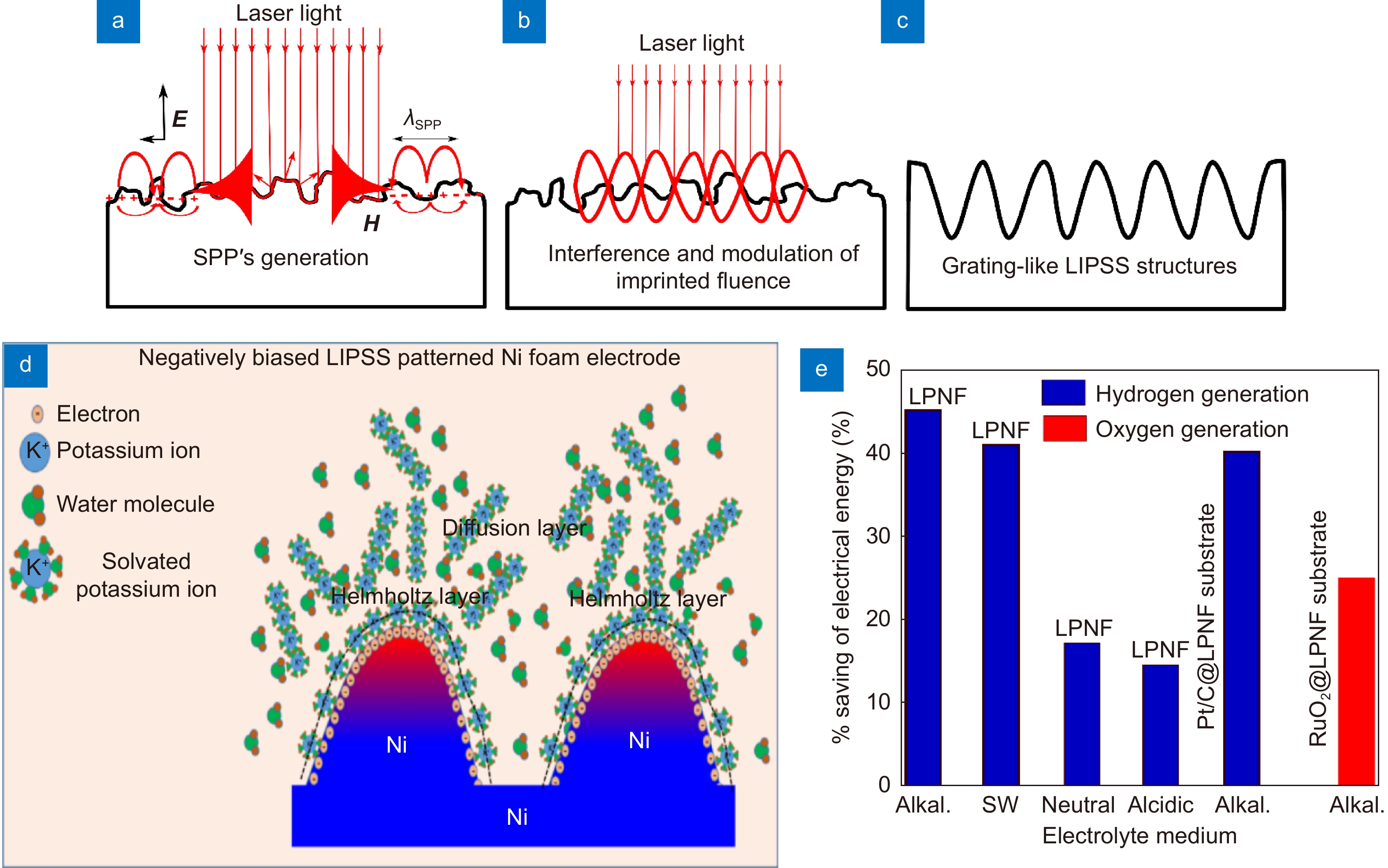

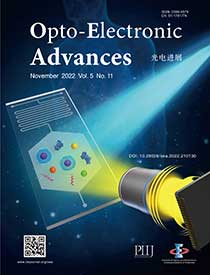
 DownLoad:
DownLoad:
